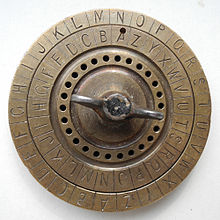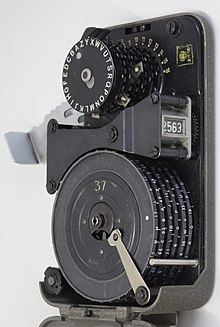CD-57
CD-57 is the name of a particularly handy mechanical rotor encryption machine , which was manufactured from 1957 by the Swede Boris Hagelin (1892–1983) at the company Crypto AG , which he founded in 1952 in Switzerland . In total, more than 12,000 copies were sold. The Bundeswehr used a variant form as the STG-61 Spruchtarngerät .
history

The trigger for the development of the CD-57 pocket cipher machine at Hagelin was the realization that in the course of time its various C-machines had become more and more voluminous due to various improvements, as well as the special interest of the French gendarmerie in a compact machine, which led to the purchase of 4,000 units signaled.
When developing the handy machine with dimensions (L × W × H) of only 130 mm × 80 mm × 38 mm and a weight of 650 g, Hagelin dispensed with a print function and used the proven cryptographic principle of his successful CX-52 . Externally, the CD-57 has two concentric rings, which, like the Alberti disk from the 15th century, have the usual 26 capital letters of the Latin alphabet . As with the classic cipher disk (picture), the outer fixed ring has the letters clockwise and the inner movable one counterclockwise. The device is held in the left hand and the thumb presses the lever. This moves a gear train inside the CD-57 (picture), which changes the assignment of the two letter rings with each press. The wheel set consists of six individual encryption disks, which differ in their subdivision along the circumference, namely 25, 26, 34, 38, 42 and 46.
A total of twelve encryption disks were available, with the divisions 25, 26, 29, 31, 34, 37, 38, 41, 42, 43, 46 and 47, from which six were selected and inserted into the machine in a certain order. Each of the discs has a corresponding number of pins along its circumference , which can be folded down by hand and then point either to the center of the disc or to the outside. Outward pointing pens are called “active”, inward pointing “inactive”.
The disk selection and its arrangement as well as the setting of active and inactive pens on each disk and the starting position represent the key . Cryptographically speaking, a new alphabet is activated for encryption with each press of the thumb . It is an involutive polyalphabetic substitution . So encryption and decryption are the same.
It is possible to name the read secret letters directly, for example on the telephone or radio , and thus to transmit an encrypted message orally. The recipient at the other end has its own CD-57, which is set identically, and converts the secret letters back into plain text accordingly . Due to the involvement of the process, reading can always be made from the outer fixed ring to the inner movable ring in both cases. The letters can also be easily noted with the right hand and then the written ciphertext can be transmitted.
The CD-57 was manufactured through 1976 and last sold for $ 900 .
STG-61
In the early 1960s, when the young Federal Republic was not yet allowed to develop its own encryption technology, the CD-57 was used in a slightly modified form by the Bundeswehr under the name Spruchtarngerät STG-61 . It was manufactured under license by the Hell works of the German inventor Rudolf Hell .
CD-57 / RT
In addition, special key strips and a so-called key strip scanner could be used. This was located on the underside or in the lower part of the small machine and replaced the six key wheels inside. The key strip it was a random tape (RT) ( German literally "Random Band" ), one with random text provided punched tape . In this way, the CD-57 / RT could use the unbreakable One-Time-Pad (OTP) ( German one-time key method ).
literature
- Wayne G. Baker: Solving a Hagelin Type CD-57 Cipher. Cryptologia , 2: 1, 1978, pp. 1-8, doi: 10.1080 / 0161-117891852730 .
- Friedrich L. Bauer : Deciphered Secrets. Methods and maxims of cryptology. 3rd, revised and expanded edition. Springer, Berlin a. a. 2000, ISBN 3-540-67931-6 .
- Boris Hagelin: The History of the Hagelin Cryptos. PDF; 9.9 MB Zug 1979, accessed on September 18, 2018.
- Louis Kruh: Cipher Equipment - Hagelin Pocket Cryptographer Type CD-57. Cryptologia, 1: 3, 1977, pp. 255-260, doi: 10.1080 / 0161-117791832986 .
- Geoff Sullivan : Cryptanalysis of Hagelin machine pin wheels. Cryptologia, 26: 4, 2002, pp. 257-273, doi: 10.1080 / 0161-110291890920 .
Web links
- CD-57 in the Crypto Museum, accessed on September 18, 2018.
- STG-61 in the Crypto Museum, accessed on September 18, 2018.
- Pocket cipher CD-57, technical description. PDF; 4.9 MB , accessed September 18, 2018.
- Pocket cipher CD-57 (functionality) PDF; 3.6 MB , accessed September 18, 2018.
- CD-57 by Crypto AG from Jerry Proc, accessed on September 18, 2018.
Individual evidence
- ↑ Boris Hagelin: The history of the Hagelin cryptos. Zug 1979, p. 36.
- ↑ a b Friedrich L. Bauer: Deciphered secrets. Methods and maxims of cryptology. 3rd, revised and expanded edition. Springer, Berlin a. a. 2000, ISBN 3-540-67931-6 , p. 81.
- ↑ Pocket cipher CD-57, technical description. S. 2. The height of "80 mm" given there is obviously a typo. The true height is about 38 mm.
- ↑ Pocket cipher CD-57 (functionality), p. 8.
- ↑ Boris Hagelin: The history of the Hagelin cryptos. Zug 1979, pp. 36-37.
- ^ Louis Kruh: Cipher Equipment - Hagelin Pocket Cryptographer Type CD-57. Cryptologia, 1: 3, 1977, p. 255.


